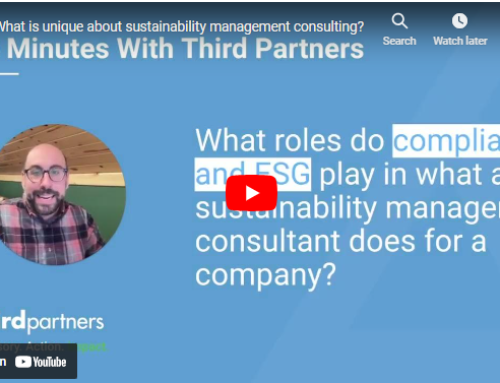Sustainability continues to grow and evolve within each sector, providing organizations with more tools and resources to address systemic challenges. Meanwhile, shifts in ESG standards and social trends have saturated markets with an overabundance of solutions that are often difficult to navigate. For any particular problem, there may be multiple solutions with no clear indication of which is the “correct” choice.
When challenges are complex, impact multiple departments, and lack a one-size-fits-all approach, an organization should consider creating an ESG working group to develop a right-sized solution.
What is an ESG working group?
An ESG working group is a team of individuals from different departments and levels of an organization that are connected by a shared interest and work to resolve a common problem. It provides a collaborative space for members of an organization to address complex issues and serves as a forum to create dialogue, propose ideas, and generate tangible solutions for gaps related to diversity, safety, retention, greenhouse gas emissions, and much more.
When should an organization consider an ESG working group?
Establish an ESG working group when presented with a cross-functional issue that requires multiple perspectives. For example, working groups often serve to improve organizational diversity, equity, and inclusion (DE&I). When asked, “How can we make our organization more inclusive?” one member might suggest email blasts for cultural holidays. A second may recommend more accessibility options for disabled employees. A third might propose sensitivity towards dietary preferences during company parties. The list goes on, and depends entirely upon each member’s unique insight and experience.
The combination of diverse, cross-departmental perspectives generates a solution that considers:
- all of the potential stakeholders impacted;
- each stakeholder’s primary needs and concerns;
- what is feasible based on available resources; and
- what can be accomplished within a reasonable timeframe.
Who should participate in an ESG working group?
Employees, management, and leadership tend to view issues from different lenses and bring unique skills to the table. From our perspective, successful ESG working groups usually include participants with the following roles and responsibilities:
| Role | Quantity | Description | Responsibilities |
|---|---|---|---|
| Chairperson | 1-2 | Goal-oriented employees, typically a manager, with leadership experience and a passion for the working group mission |
|
| Executive Sponsor | 1 | A member of the Executive Leadership Team (ELT) |
|
| Member |
4-7 |
Goal-oriented employees with a passion for the working group mission |
|
How does an organization start an ESG working group?
Select qualified individuals to serve as the chairperson and the executive sponsor, then meet with them to define the following working group parameters:
| Guiding Questions | Example Responses | |
|---|---|---|
| Mission |
|
“Our mission statement outlines our commitment to become a leader in community engagement and empower our employees to give back.” |
| Goals and Initiatives |
|
“We will provide employees with volunteer time off (VTO) and host company-wide events to promote charity and volunteerism.” |
| Key Performance Indicators (KPIs) |
|
“We will measure the amount of VTO used annually. By 2025, we would like employees to claim 90% of VTO.” |
| Members |
|
“The working group will be open to all employees with an interest in community engagement.” |
Before the working group convenes (monthly or quarterly), the chairperson should arrange a plenary session to socialize the working group’s mission. The working group may disband once its mission has been accomplished.
What makes an ESG working group productive?
Effective working groups are productive. They utilize agendas to maintain focus, track ownership and accountability, and ensure deadlines are met for each individual task, while reducing the likelihood of mistakes and miscommunication. An annotated agenda including comments and next steps is often distributed after each meeting.
Teamwork is essential. Members may forget tasks or struggle to balance their participation in the working group with their job-specific responsibilities. It is the chairperson’s duty to follow up with reminders and guidance. The members’ duties are to support one another and maintain accountability.
How can Third Partners help?
If you believe an ESG working group can develop right-sized solutions for your organization’s sustainability-related challenges, Third Partners can get the ball rolling. As part of our Roadmap and Action Plan, we develop frameworks and support plans for strategic, self-governing working groups.
Contact us for a free consultation.



